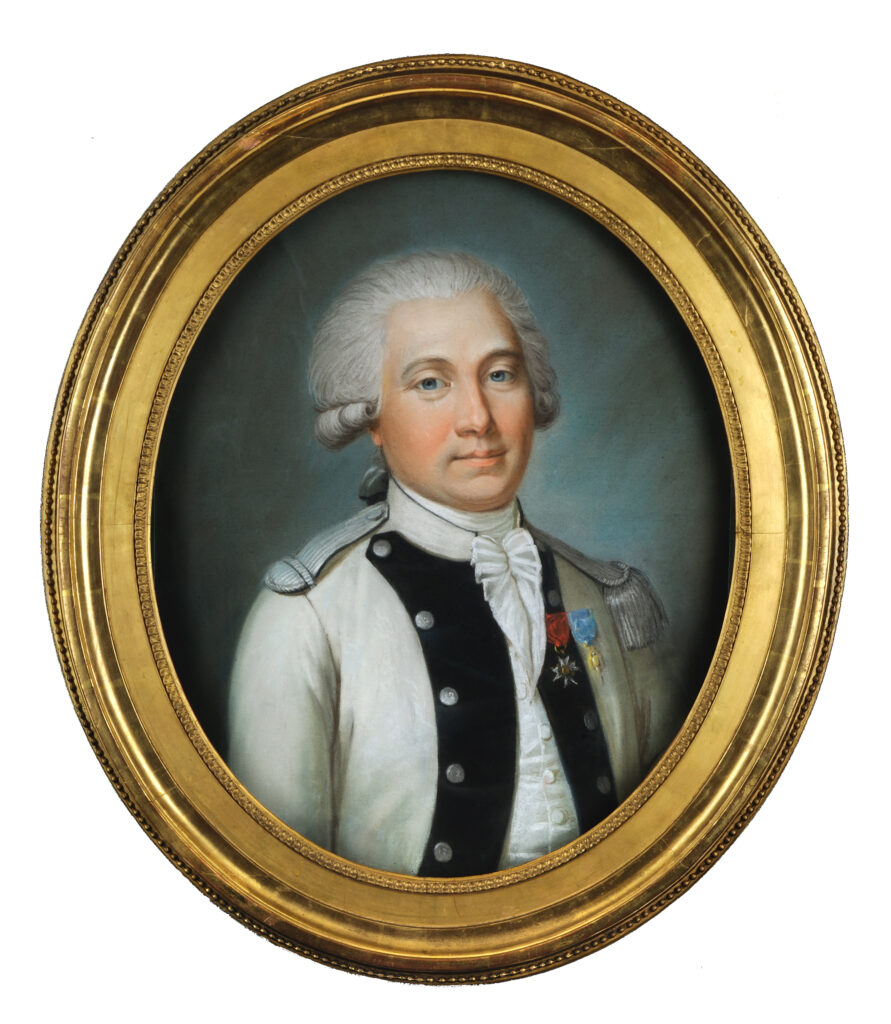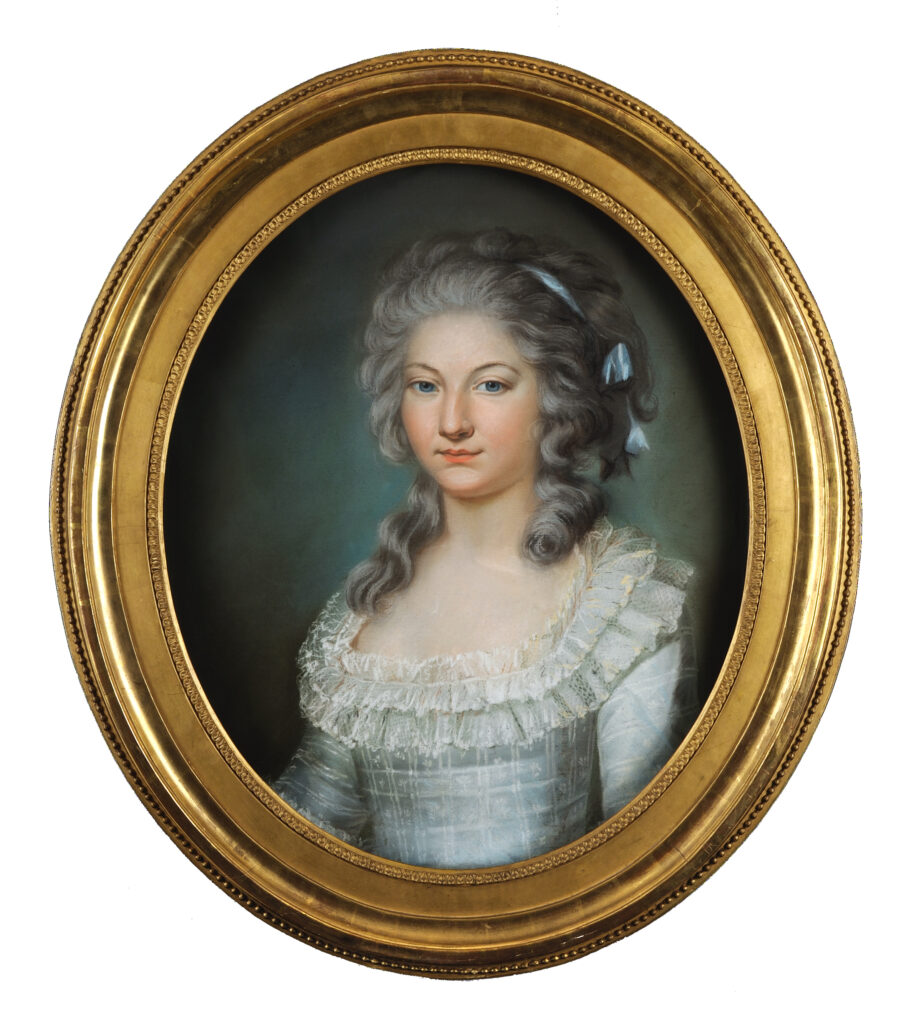 One of the most popular artforms of the eighteenth century, pastels offer a lifelike and beautifully textured painting, but their inherent fragility has made it less common for them to survive than their ubiquitous oil counterparts. The Institute’s museum collections contain a dozen pastel portraits of Revolutionary War participants—among them a pair of pastels depicting Philippe-Jacques-François Aupépin de Lamothe, an officer in the French army during the American Revolution, and his wife, Anne-Marie. The portraits were painted by Charles Thévenin in Paris in 1786—not long after Captain Aupépin de Lamothe returned from six years at war in America. The Institute acquired the portraits in 2021 after they had been in private collections in France for more than two hundred years. The pastels showed signs of damage from water, insects and other sources, and their gilt wood frames had splits and missing decorative elements. A team of conservators, working in consultation with our collections staff, labored for nearly a year to treat this damage and to create proper housings for the paintings. Along the way, they uncovered new information about the history of the portraits and their frames. Their efforts have helped to save these artworks for future generations to study and enjoy.
One of the most popular artforms of the eighteenth century, pastels offer a lifelike and beautifully textured painting, but their inherent fragility has made it less common for them to survive than their ubiquitous oil counterparts. The Institute’s museum collections contain a dozen pastel portraits of Revolutionary War participants—among them a pair of pastels depicting Philippe-Jacques-François Aupépin de Lamothe, an officer in the French army during the American Revolution, and his wife, Anne-Marie. The portraits were painted by Charles Thévenin in Paris in 1786—not long after Captain Aupépin de Lamothe returned from six years at war in America. The Institute acquired the portraits in 2021 after they had been in private collections in France for more than two hundred years. The pastels showed signs of damage from water, insects and other sources, and their gilt wood frames had splits and missing decorative elements. A team of conservators, working in consultation with our collections staff, labored for nearly a year to treat this damage and to create proper housings for the paintings. Along the way, they uncovered new information about the history of the portraits and their frames. Their efforts have helped to save these artworks for future generations to study and enjoy.
Born at Château de Dreuzy in the department of Nièvre in the Burgundy region of France, Philippe-Jacques-François Aupépin de Lamothe (1752-1818) began his career in the French military in 1763 as an ensign in the Marine Regiment. When the Auxerrois Regiment was formed in 1776, Aupépin de Lamothe was transferred to the infantry unit and promoted to lieutenant. The following year he sailed for the West Indies, where he would participate in nearly a dozen engagements as the British and French empires fought over their valuable sugar islands. Aupépin de Lamothe was wounded during the first two battles in which he fought: the French capture of Dominica in September 1778 and their defeat at St. Lucia three months later. The Auxerrois Regiment sailed with Admiral d’Estaing’s squadron in 1779, when Aupépin de Lamothe fought in the French victory at Grenada as well as the unsuccessful joint French-American siege of Savannah. Returning to the Caribbean, he participated in the Battle of Martinique and two other naval engagements with Admiral Guichen’s squadron in 1780—the year he was promoted to captain—and in the French capture of Tobago in the early summer of 1781. For his conduct in the capture of St. Eustatius in late 1781, Aupépin de Lamothe received the cross of the Order of Saint Louis, a royal award for exceptional and long-serving Catholic officers in the French military. Aupépin de Lamothe’s last battle in America came in early 1782, when he participated in the successful Siege of Brimstone Hill on St. Kitts. The Auxerrois Regiment arrived back in France in July 1783 after six years at war.
In 1784 Aupépin de Lamothe returned to his native Nièvre and married Anne-Marie Petit de Vaujetin (d. 1816). He joined the French branch of the Society of the Cincinnati, whose members treasured their association with George Washington, the organization’s president general, and the part they played in Britain’s defeat in America. Aupépin de Lamothe continued to serve in the French army, being transferred to the Viennois Regiment as a major in 1788 and promoted to his final rank of colonel in 1792. He resigned the next year as the French Revolution became more radical. He later served as mayor of Varzy before his death in 1818. He and his wife had two surviving children, who inherited the portraits and whose descendants preserved them into the twentieth century.
The portrait of Aupépin de Lamothe depicts him in the uniform of a captain-commandant in the Auxerrois Regiment, as he appeared at the end of his service in America. The white coat with dark blue facings has silver-toned buttons each bearing the number “12” as the Auxerrois was designated the twelfth regiment of the French army. The full epaulet on his left shoulder and contra epaulet, without fringe, on his right shoulder indicate the rank of captain-commandant. A captain-commandant, or first captain, was the commanding officer of a troop or company of the regiment. The cross of the Saint Louis and the Society of the Cincinnati Eagle—symbols of his service in America—hang prominently on his coat.
 When Captain Aupépin de Lamothe commissioned these portraits in 1786, pastels were at the height of their popularity in Europe—particularly in France, where the top pastelists were as highly regarded and successful as artists of oil paintings. Charles Thévenin (1764-1838), who painted the pastel portraits of Captain and Madame Aupépin de Lamothe, worked in his native Paris as well as Rome from the 1780s to well into the nineteenth century. He created them using typical French pastel techniques of the time. He painted the likenesses on a medium-weight blue paper using pastel crayons that combined pigment, a filler (that provided opacity and body to the color), and a light binder. He applied the pigment to the paper with the crayons, then spread it and refined the picture using either his finger or a tightly rolled piece of paper or leather. Before the portraits were painted, the paper was adhered to a canvas stretched on a wooden strainer to provide support. After the portraits were painted, they were framed behind glass to protect the fragile, powdery nature of the pastel.
When Captain Aupépin de Lamothe commissioned these portraits in 1786, pastels were at the height of their popularity in Europe—particularly in France, where the top pastelists were as highly regarded and successful as artists of oil paintings. Charles Thévenin (1764-1838), who painted the pastel portraits of Captain and Madame Aupépin de Lamothe, worked in his native Paris as well as Rome from the 1780s to well into the nineteenth century. He created them using typical French pastel techniques of the time. He painted the likenesses on a medium-weight blue paper using pastel crayons that combined pigment, a filler (that provided opacity and body to the color), and a light binder. He applied the pigment to the paper with the crayons, then spread it and refined the picture using either his finger or a tightly rolled piece of paper or leather. Before the portraits were painted, the paper was adhered to a canvas stretched on a wooden strainer to provide support. After the portraits were painted, they were framed behind glass to protect the fragile, powdery nature of the pastel.
The portraits were originally rectangular, with corresponding rectangular frames, but they no longer retain that shape. At some point the corners of the paintings and strainers were cut off to fit the pastel portraits into the present oval frames—high-quality French frames that were made around the time the portraits were painted, but were not original to these artworks. The retrofitting was done somewhat crudely, using pieces from the cut frames to brace the corners, and leaving ragged edges of the pastel paper and backing canvas in areas. Somewhat crude particle board stripping was nailed around the outside edges of the stretchers of the now-octagonal pictures to space the pastels away from the glass in the oval frames. The original paper dust seal that at one time had been in place across the hollow of the back of the canvas was torn away during the retrofitting. A French newspaper fragment—possibly from the late nineteenth or early twentieth century—glued to the strainer on the captain’s portrait may be a clue to when the retrofitting was done.
When we acquired the pastel portraits, the paintings showed evidence of water, insect and other damage and were not in displayable condition. Tidelines and wrinkles in the background of both portraits indicated water damage, which, during an old restoration effort, was overpainted in a heavily applied pastel color that does not match the original blue. Dust and remnants of insects had accumulated on both the front and back surfaces of the paintings. Several tears through the paintings and canvas were also present in both portraits. The oval frames were also warped and had several cracks in the gilded surface, damaged gesso and missing bead ornaments.
The Institute contracted with Sylvia Albro, a conservator of works on paper, and Gold Leaf Studios, which specializes in frame conservation, to treat the portraits and frames. The pastel portraits were dry cleaned to remove surface dirt and insect particles, the later acidic particle board stripping was removed, tears were repaired with color-matched paper pulp, and pigment losses were inpainted with antique French pastels. As the original pastel paintings are very powdery and fragile, we decided it was too risky to remove the overpaint in the background of the pictures. The frames had glue injected into cracks, gesso losses inpainted, missing ornaments replaced with newly cast pieces and missing gilding replaced with 23-karat gold leaf water gilded onto the existing surfaces.
Part of the conservation of the paintings and the frames was devising more appropriate long-term housings to preserve the fragile portraits. The conservators devised a custom archival box in which to seal the pastels to provide a more climate-controlled environment for them. Each pastel portrait was set into an archival box custom-made to fit their octagonal shape. The boxes are deeper than the portraits with spacers providing a buffer between the surface of the pastels and the glazing above them. A piece of low-static, UV-filtering acrylic was placed over the pastels and sealed to the archival boxes to prevent dust and acidity from building up inside the housings. The back sides of the frames were built up to accommodate the depth of these custom housings.